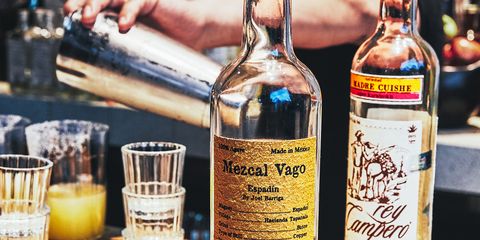ONE IS A PSYCHOTROPIC HALLUCINOGEN THE OTHER IS JUST ALCOHOL
There's more to the agave spirit than smoke and worm salt.

JEFF GORDINIERMAY 17, 2018

LAURA MURRAY
In the folklore of my family, there is one night that remains legendary. We had traveled to Cancún, the gabachos-in-big-sombreros Mexican resort city that was built on the concept of a never-ending spring break, to celebrate New Year’s Eve with the proper measure of ridiculousness. I don’t remember much about it, but my siblings do. They remember gazing out at a dance floor in a nightclub after midnight and seeing me, then in my early 20s, writhing around in a manner that was perhaps meant to summon the spirit of Quetzalcoatl, the Mesoamerican deity usually depicted as a feathered serpent. My brother and sister could find me in the crowd because I had managed to climb on top of a giant amplifier, which meant that my euphoric contortions were on full display for everyone in the club.

Beverage director Yana Volfson of New York’s Atla and Cosme.
Laura Murray
This Walpurgisnacht of wild abandon was later attributed to a lone culprit: mezcal. I had downed a lot of cheap mezcal that night, although I had no idea what it was. In those days, American tourists still liked to cling to the myth that the “worm” floating around in the bottle would make them hallucinate. (You can’t blame the locals for perpetuating this prank.) By now, of course, U.S. drinkers have graduated from such callow delusions, and this infinitely complex agave spirit, whether stirred into cocktails or sipped on its own, has been treated with the reverence it deserves for more than a decade. In fact, there are so many compelling bottles on store shelves that it’s hard to keep track, and it’s a telling indicator of popular thirst that George Clooney and his billionaire Casamigos comrades have announced their own plans to move into the mezcal marketplace.
If I’m being honest, though, I still can’t pretend to have a grasp on what mezcal is all about. It’s the sort of spirit that has a habit of eluding anyone who tries to pin it down. Which is why I met up with Yana Volfson, the beverage director at Mexican chef Enrique Olvera’s two outposts in New York, Atla and Cosme, for an afternoon agave tutorial. Joining Volfson at Atla was Jorsand Díaz, the head bartender and self-described “mezcal nerd” at both restaurants. And the first thing the two of them stressed to me was that mezcal mastery is even more slippery than an amateur may realize.
It’s a telling indicator of popular thirst that George Clooney and his billionaire Casamigos comrades have announced their own plans to move into the mezcal marketplace.
“We strive so hard for that idea of consistency,” Volfson said. “There’s really no such thing.” Surrender to flux—from bottle to bottle, day to day, she advised. “Mezcal can taste one way one day and taste different the next day. Just like no two chiles are ever going to taste the same.”
“The more passion that I have, the more questions I have,” Díaz added.
But where to begin, if mezcal qualifies as such a moving target? It helps to start off by forgoing stereotypes. Perhaps you’re prone to bluffing your way through a bar order by asking for something “smoky,” which is like saying “funky” in a natural-wine bar or “hoppy” in a craft brewery. Stop. Smoke is not always the most pronounced element in mezcal, nor must it be viewed as the chief virtue.

Pairings with El Jolgorio and Rey Campero mezcals.
Laura Murray
Instead of pairing mezcal with the clichéd worm salt and wedge of citrus, Volfson and Díaz will, at Atla, entice customers with curveball accompaniments that come across as a revelation. I sampled three bottles. Each bloomed on my palate when hitched to an unexpected nibble. The first was an espadín (from the most commonly used agave plant) that mezcalero Joel Barriga had made for Vago; it was “milky” and “buttery,” Volfson said, and she paired it with chocolate-covered espresso beans. Then she described Rómulo Sánchez Parada’s 2015 madre-cuishe, for Rey Campero, as “stemmy,” green-grassy, eucalyptus-tinged; she had me drink that one with slices of smoked salmon. The third portal, Reynaldo Altamirano’s wild-agave tepeztate, for El Jolgorio, brought out the poetry in Volfson. She paired it with blue cheese, declaring that it would take me “far up into the sky and deep, deep into the ocean, in terms of its flavor.”
Wait. Maybe mezcal can make you hallucinate after all. I suppose the trick is to open your mind first. “Walk through one door,” Volfson told me, “and then I’ll open up another door for you.”

This article appears in the May ’18 issue of Esquire.
Alexi Lubomirski
No comments:
Post a Comment